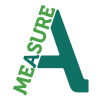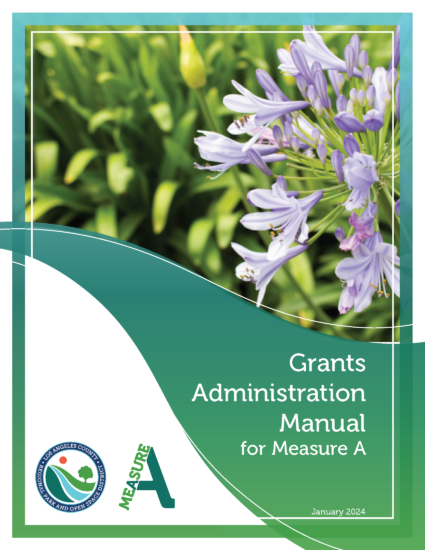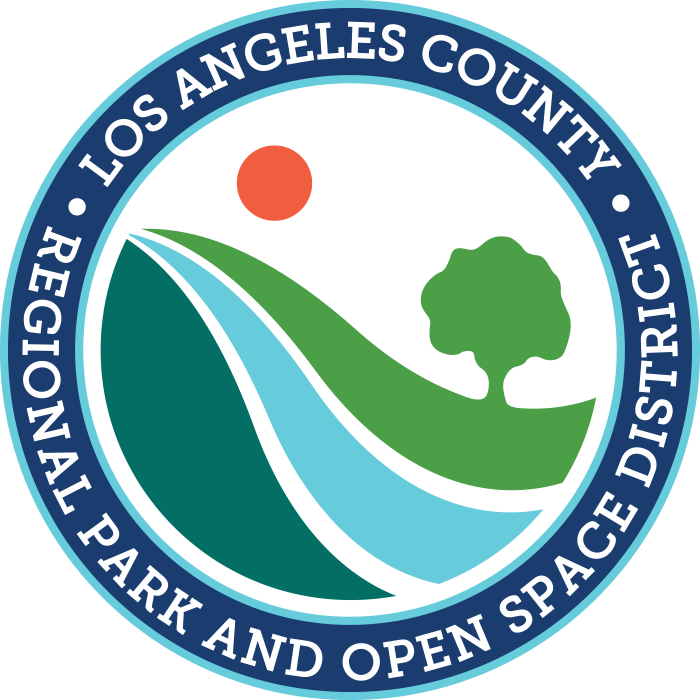Grants Administration Manual
Measure A

The Los Angeles County Regional Park and Open Space District (RPOSD) is responsible for implementing and administering the Los Angeles County Safe, Clean Neighborhood Parks and Beaches Measure of 2016 (Measure A). On this page, you can access and refer to current and previous editions of the Measure A Grants Administrative Manual (GAM).
The GAM provides guidance in applying for and administering Measure A funds to ensure successful implementation of park and open space projects throughout Los Angeles County.
Measure A General Policies
Measure A allows for the adjustment of the rate of the tax based on cumulative increases to the Western Urban Consumer Price Index (WUCPI) from July 1, 2017. Adjustments to the tax rate are set as follows:
The tax rate shall be automatically adjusted every two years to the maximum rate allowed by the CPI Update Formula. The CPI Update Formula shall be calculated as follows:
-
- ($0.015) x (WUCPI on July 1 of the previous calendar year) ÷ (WUCPI on July 1, 2017) = Maximum adjusted tax rate per square foot, rounded to the nearest one-tenth of a cent.
-
- The Board of Supervisors may, in any given year, choose to adjust the tax rate to a rate less than the maximum.
Measure A provides for the updating of the 2016 Los Angeles Countywide Parks & Recreation Needs Assessment (PNA). These updates shall include the Regional Recreation, Beaches, Rural Areas and Open Space Assessment, adopted by the Board in 2022. To ensure an inclusive, transparent and consistent regional approach and to eliminate entrenched park investment disparities, these two assessments will be incorporated into the Unified Los Angeles Countywide Comprehensive Parks and Recreation Needs Assessment (UPNA) by 2031. These updates shall occur as follows :
PARK INVENTORY DATA
All park entities shall update their park inventory data annually as a requirement of eligibility to receive Measure A funds. This update shall include park names, park locations, park sizes, and quantity and condition of identified standard amenities within each park, as described in the PNA. Verifying existing data and providing any necessary updates is required to remain in Good Standing with RPOSD.
PARK NEED BY STUDY AREA MAP
- Updated park inventory data and US Census population numbers as adjusted by Los Angeles County shall be used to update the Park Need by Study Area Map periodically.
- Updated park inventory data and US Census population numbers as adjusted by Los Angeles County shall be used to update the Park Need by Study Area Map periodically.
Unified Parks and Recreation Needs Assessment (UPNA) Update
- The UPNA shall be updated once every ten years, beginning in 2031.
- Every update of the UPNA shall contain at a minimum the metrics used in the 2016 PNA and the 2022 PNA+ to ensure the ability to track changes over time.
- Designation of Study Area park need levels shall be updated concurrently with the update of the UPNA.
- With support and oversight by the Regional Parks and Open Space District, the Los Angeles County Department of Parks and Recreation shall serve as the lead agency in the updates of the UPNA.
PARKS NEEDS ASSESSMENT PLUS
- The 2022 Parks Needs Assessment Plus (PNA+) was conducted by the Los Angeles County Department of Parks and Recreation to identify and analyze the environmental conservation and restoration, regional recreation, and rural recreation needs of the County.
The results of the PNA+ shall be used to help inform project planning and project selection for competitive grants, including Categories 3: Natural Lands, Local Beaches, Water Conservation & Protection and Category 4: Regional Recreation, Multi-Use Trails and Accessibility.
The Board of Supervisors, acting as the Board of the Regional Park and Open Space District, shall allocate two (2) percent of Measure A revenue for County priority projects:
- Each Supervisor’s District shall receive one-fifth of the total amount of funds available annually. These funds may be expended annually or may accumulate.
- Eligible expenditures include all phases of capital park projects, including planning and design, and Supervisors may use their funds to jointly fund eligible projects.
Under Measure A, allocations from the Community-based Park Investment Program and the Neighborhood Parks, Healthy Communities, & Urban Greening Program represent relatively fixed funding allocations that are to flow to and be expended within specific Study Areas by the Agency of Record. However, due to distribution of local resources, land availability, and other local conditions, it is likely that transferring Annual Allocation funds between Study Areas could benefit residents of all Study Areas involved.
A public agency receiving Annual Allocation under the Community-based Park Investment Program and Neighborhood Parks, Healthy Communities, & Urban Greening Program may consider transferring Annual Allocation funds in one of the following ways:
- Utilize funds associated with a Study Area for which it is the Agency of Record for a project in an adjacent Study Area for which it is the Agency of Record;
- Transfer funds associated with a Study Area for which it is the Agency of Record to an immediately adjacent Study Area for which it is not the Agency of Record;
- Transfer funds to a Study Area identified as High or Very High Need from a Study Area not defined as High or Very High Need; or
- Transfer funds associated with a Study Area for which it is the Agency of Record to another agency that owns and/or operates parks in said Study Area.
Such transferring of Annual Allocation funding may occur provided that:
- Funds may not be transferred to an area of less park need (Ex. Funds from a High Need Study area may not be transferred to a low or moderate need study area.
- The funds will be expended on a specific project or projects that are eligible for Measure A funds.
- The agency initiating the request demonstrates to RPOSD’s satisfaction that all Study Area(s) involved will benefit from the transferring of funds and resulting project(s). To do this, the agency must provide the following:
-
- Describe the public benefits to the community(ies) from where the funds are being transferred.
-
- GIS data showing the service area of the proposed project(s) based on local, State, or National standards for the project type(s)
- Information about project accessibility for all involved Study Areas
- Evidence of support from communities in all Study Areas involved. This evidence must be the result of meaningful community engagement conducted by all entities involved in the transferring of funds.
- RPOSD determines that the proposed transferring of funds will result in timely completion of the park project(s); and
- The governing body of each public agency has authorized the transferring of funds for a specific project or projects.
If all five provisions above are true, the relinquishment of funds from the donor Study Area(s) to recipient Study Area(s) may be approved at RPOSD’s sole discretion for use on the identified project or projects.
RPOSD recognizes the importance of lowering barriers to accessing and administering Measure A funds to meet the park needs of all residents of Los Angeles County. The following set of grant-making policies are recommended for administering Measure A Funds.
PROJECT TYPES
Every competitive grant program will fund project types that are in and/or serve High-Need or Very-High-Need Study Areas. Descriptions of each competitive grant program cycle will provide examples of project types that could occur in and/or serve High-Need or Very-High-Need communities.
EVALUATION CRITERIA
All competitive grant programs will include a “Level of Need” evaluation criterion. This criterion, depending on the specific grant program, will consider whether or not a project or program serves or benefits residents of High-Need or Very-High-Need Study Areas, or in rural areas of the County or provides services to and/or recruits a majority of its participants from High-Need or Very-High-Need Study Areas.
LONG-RANGE PLANNING
Measure A funded projects will be consistent with each Study Area’s long-range park planning documents, such as a parks master plan, community plan, or other adopted planning document (such as the Countywide Neighborhood Parks and Recreation Needs Assessment).
COMMUNITY ENGAGEMENT
RPOSD requires appropriate, thorough, and timely community outreach and engagement for all projects funded by Measure A to ensure inclusion, input, and support from the public.
MONITORING AND CORRECTION
RPOSD consistently monitors, tracks, and if necessary, adjusts the administration of both competitive funding and Annual Allocations to ensure that the goals of Measure A are being met.
TECHNICAL ASSISTANCE
RPOSD will provide Technical Assistance to potential applicants and grantees throughout the stages of the grant process to ensure that barriers to applying for, receiving, and administering funding are reduced, and that the goals of Measure A are being met. Technical Assistance provided through the Technical Assistance Program (TAP) is exclusively for the 30 eligible entities that are in High or Very High Need Study Areas.
TARGETING FUNDS
A portion of competitive grant funds will be designated for projects strictly located in High-Need or Very-High-Need Study Areas.
- This would affect the following programs:
- Natural Lands, Local Beaches, Water Conservation and Protection Competitive Grants;
- Regional Recreation, Multi-use Trails and Accessibility Competitive Grants; and
- Acquisition-Only Grants.
The portion of funds to be targeted is set at a minimum of 30 percent. This percentage will be evaluated periodically and may increase in future years based on the evaluation of metrics tracked by RPOSD, such as for funds and competitive grant programs.
A portion of competitive grant funds will be designated for projects strictly located in High Need or Very High Need Study Areas.
- This would affect the following programs:
- Natural Lands, Local Beaches, Water Conservation and Protection Competitive Grants;
- Regional Recreation, Multi-use Trails and Accessibility Competitive Grants; and
- Acquisition-Only Grants.
The portion of funds to be targeted is set at a minimum of 30 percent. This percentage will be evaluated periodically and may increase in future years based on the evaluation of metrics tracked by RPOSD, such as for funds and competitive grant programs.
2024 Edition of Measure A GAM

RPOSD updated the Measure A GAM. The 2024 edition is effective January 1, 2024.
As part of the GAM update process, RPOSD held a preview session with its stakeholders on November 15, 2023, to review the new changes. The recording of the session, along with the questions and answers, are available for you to review on this webpage.
Watch the GAM Update Preview Session Recording
Archive
The following are previous editions of the Measure A GAM that have since been revised and replaced.

